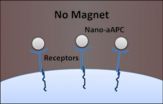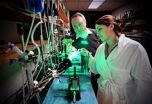(Press-News.org) ATHENS, GA--Managing the quality and quantity of freshwater resources is one of the most serious environmental challenges of the 21st century. Global population growth and increasing urbanization have resulted in increased competition for water resources among domestic, industrial, and agricultural users. Challenged to find ways to manage irrigation needs while recognizing the limitations of freshwater resources, many commercial horticulture operations are showing increased interest in the use of wireless sensor networks (WSN)--technology designed to both monitor and control irrigation events. A review published in HortTechnology highlights the recent advances in specific WSN technology and discusses implications for its use in commercial horticulture settings.
"Previous studies have demonstrated the utility of sensor-controlled irrigation," explained Matthew Chappell, lead author of the report. "The subsequent step in facilitating adoption of this technology has been the on-farm implementation of soil moisture-based irrigation hardware and software developed as part of the U.S. Department of Agriculture (USDA) Specialty Crops Research Initiative Project." Chappell and colleagues at the University of Georgia's Department of Horticulture reported on the implementation and use of these WSNs at three commercial nursery and greenhouse operations in Georgia.
The report focused on the use of capacitance-based soil moisture sensors to both monitor and control irrigation events. "Since on-farm testing of these wireless sensor networks (WSNs) to monitor and control irrigation scheduling began in 2010, WSNs have been deployed in a diverse assortment of commercial horticulture operations," the authors said. They said that improved software and hardware have resulted from the challenges and successes experienced by growers, and grower confidence in WSNs has subsequently improved.
"Growers are using WSNs in a variety of ways to fit specific needs, resulting in multiple commercial applications," Chappell noted. "Some growers use WSNs as fully functional irrigation controllers. Other growers use components of WSNs, specifically the web-based graphical user interface (GUI), to monitor grower-controlled irrigation schedules."
"The case studies we documented exemplify the advancements that can be made in product development, deployment, and implementation when researchers work together with commercial growers," said Chappell. He noted that the research project has resulted in successful WSN implementation at three commercial nurseries in Georgia, which now trust and rely on WSN data not only to monitor substrate moisture but also to control irrigation. "Based on the positive experiences and comments from our grower collaborators, other growers have been eager to try WSNs in their operations."
The researchers concluded that the main factor limiting wide-scale adoption of is the lack of a commercially available WSN hardware and software designed specifically for the ornamental plant industry.
INFORMATION:
The complete study and abstract are available on the ASHS HortTechnology electronic journal web site: http://horttech.ashspublications.org/content/23/6/747.abstract
Founded in 1903, the American Society for Horticultural Science (ASHS) is the largest organization dedicated to advancing all facets of horticultural research, education, and application. More information at ashs.org.
Report details multiple commercial uses of wireless sensor networks
Cases studies show WSNs used for both monitoring, controlling irrigation in container nurseries
2014-02-25
ELSE PRESS RELEASES FROM THIS DATE:
Analysis: 32 years of US filicide arrests
2014-02-25
PROVIDENCE, R.I. [Brown University] — Instances in which parents kill their children may seem so horrifying and tragic that they defy explanation. Published scientific and medical research, meanwhile, doesn't offer much epidemiological context to help people understand patterns among such heinous crimes. A paper in the March edition of the journal Forensic Science International provides the first comprehensive statistical analysis of filicide in the United States, drawing on 32 years of data on more than 94,000 arrests. The study also explores possible underlying psychiatric ...
CWRU researchers find byproducts of bacteria-causing gum disease incite oral cancer growth
2014-02-25
Researchers from Case Western Reserve University have discovered how byproducts in the form of small fatty acids from two bacteria prevalent in gum disease incite the growth of deadly Kaposi's sarcoma-related (KS) lesions and tumors in the mouth.
The discovery could lead to early saliva testing for the bacteria, which, if found, could be treated and monitored for signs of cancer and before it develops into a malignancy, researchers say.
"These new findings provide one of the first looks at how the periodontal bacteria create a unique microenvironment in the oral cavity ...
Eliminating maternal mortality could extend life expectancy in reproductive ages
2014-02-25
Maternal death rates represent the single largest health discrepancy between developed and developing populations, with nearly all - over 99% -- maternal deaths worldwide occurring in developing countries and over half of them in sub-Saharan Africa countries. Eliminating maternal mortality, which is defined as the deaths related to pregnancy, would result in a gain of over a half year (0.6 years) in life expectancy worldwide, according to a new study by researchers at Johns Hopkins Bloomberg School of Public Health. The study is published February 13 in PLOS ONE.
Over ...
Magnetic medicine
2014-02-25
Using tiny particles designed to target cancer-fighting immune cells, Johns Hopkins researchers have trained the immune systems of mice to fight melanoma, a deadly skin cancer. The experiments, described on the website of ACS Nano on February 24, represent a significant step toward using nanoparticles and magnetism to treat a variety of conditions, the researchers say.
"Size was key to this experiment," says Jonathan Schneck, M.D., Ph.D., a professor of pathology, medicine and oncology at the Johns Hopkins University School of Medicine's Institute for Cell Engineering. ...
3-D printer creates transformative device for heart treatment
2014-02-25
Igor Efimov, PhD, at the School of Engineering & Applied Science at Washington University in St. Louis and an international team of biomedical engineers and materials scientists have created a 3-D elastic membrane made of a soft, flexible, silicon material that is precisely shaped to match the heart's epicardium, or the outer layer of the wall of the heart. Current technology is two-dimensional and cannot cover the full surface of the epicardium or maintain reliable contact for continual use without sutures or adhesives.
The team can then print tiny sensors onto the membrane ...
Vitamin A may help boost immune system to fight tuberculosis
2014-02-25
Tuberculosis is a major global problem, affecting 2 billion people worldwide and causing an estimated 2 million deaths annually. Western countries are once again tackling the disease, with recent outbreaks in Los Angeles and London.
The rise of drug-resistant TB, called a "ticking time bomb" by the World Health Organization, and the high cost of fighting the disease highlight the need for new approaches to treatment.
In findings published in the March 1 issue of the Journal of Immunology, UCLA researchers investigating the role of nutrients in helping the immune ...
Discovery of a 'conductor' in muscle development
2014-02-25
Montréal, February 25, 2014 – A team led by Jean-François Côté, researcher at the IRCM, identified a ''conductor'' in the development of muscle tissue. The discovery, published online yesterday by the scientific journal Proceedings of the National Academy of Sciences (PNAS), could have an important impact on the treatment of muscular diseases such as myopathies and muscular dystrophies.
"For several years, we have been studying myogenesis, a process by which muscles are formed during embryonic development," says Jean-François Côté, PhD, Director of the Cytoskeletal Organization ...
Psychological side-effects of anti-depressants worse than thought
2014-02-25
LIVERPOOL, UK – 26 February 2014: A University of Liverpool researcher has shown that thoughts of suicide, sexual difficulties and emotional numbness as a result of anti-depressants may be more widespread than previously thought.
In a survey of 1,829 people who had been prescribed anti-depressants, the researchers found large numbers of people – over half in some cases – reporting on psychological problems due to their medication, which has led to growing concerns about the scale of the problem of over-prescription of these drugs.
Psychologist and lead researcher, Professor ...
New record set for data-transfer speeds
2014-02-25
WASHINGTON, Feb. 25, 2014 – Researchers at IBM have set a new record for data transmission over a multimode optical fiber, a type of cable that is typically used to connect nearby computers within a single building or on a campus. The achievement demonstrated that the standard, existing technology for sending data over short distances should be able to meet the growing needs of servers, data centers and supercomputers through the end of this decade, the researchers said.
Sending data at a rate of 64 gigabits per second (Gb/s) over a cable 57 meters long using a type ...
NHS Scotland reduces post-code lottery for hip replacement surgery
2014-02-25
Tuesday 25 February – A reduction in the post-code lottery for hip replacement surgery has been achieved in Scotland without recourse to the private sector, according to new research published in the Journal of the Royal Society of Medicine. Using NHS Scotland data, researchers at the Centre for Primary Care and Public Health at Queen Mary University of London with colleagues from the University of Edinburgh and Lothian University Hospitals NHS Trust, show that access to hip replacement increased and geographical inequalities improved across all geographical health boards ...
LAST 30 PRESS RELEASES:
University of Oklahoma researcher awarded funding to pursue AI-powered material design
Exploring how the visual system recovers following injury
Support for parents with infants at pediatric check-ups leads to better reading and math skills in elementary school
Kids’ behavioral health is a growing share of family health costs
Day & night: Cancer disrupts the brain’s natural rhythm
COVID-19 vaccination significantly reduces risk to pregnant women and baby
The role of vaccination in maternal and perinatal outcomes associated with COVID-19 in pregnancy
Mayo Clinic smartwatch system helps parents shorten and defuse children's severe tantrums early
Behavioral health spending spikes to 40% of all children’s health expenditures, nearly doubling in a decade
Digital cognitive behavioral treatment for generalized anxiety disorder
Expenditures for pediatric behavioral health care over time and estimated family financial burden
Air conditioning in nursing homes and mortality during extreme heat
The Alps to lose a record number of glaciers in the next decade
What makes a good proton conductor?
New science reporting guide published for journalists in Bulgaria
New international study reveals major survival gaps among children with cancer
New science reporting guide published for journalists in Turkey
Scientists develop a smarter mRNA therapy that knows which cells to target
Neuroanatomy-informed brain–machine hybrid intelligence for robust acoustic target detection
Eight SwRI hydrogen projects funded by ENERGYWERX
The Lundquist Institute and its start-up company Vitalex Biosciences Announces Strategic Advancement of Second-Generation fungal Vaccine VXV-01 through Phase 1 Trials under $40 Million Competitive Con
Fine particles in pollution are associated with early signs of autoimmune disease
Review article | Towards a Global Ground-Based Earth Observatory (GGBEO): Leveraging existing systems and networks
Penn and UMich create world’s smallest programmable, autonomous robots
Cleveland researchers launch first major study to address ‘hidden performance killer’ in athletes
To connect across politics, try saying what you oppose
Modulating key interaction prevents virus from entering cells
Project explores barriers to NHS career progression facing international medical graduates
Jeonbuk National University researchers explore the impact of different seasonings on the flavor perception of Doenjang soup
Two Keck Medicine of USC Hospitals named Leapfrog Top Teaching Hospitals
[Press-News.org] Report details multiple commercial uses of wireless sensor networksCases studies show WSNs used for both monitoring, controlling irrigation in container nurseries


